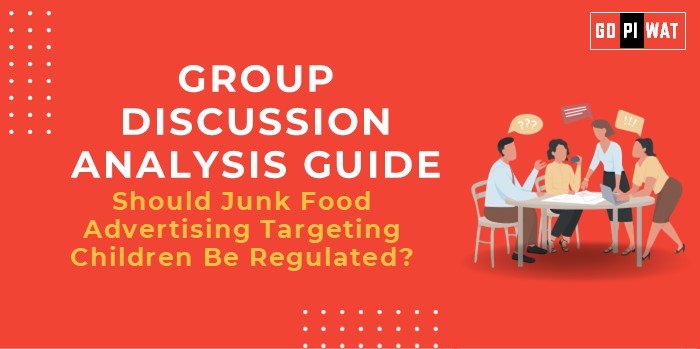📋 Group Discussion (GD) Analysis Guide
🌟 Topic: Should Junk Food Advertising Targeting Children Be Regulated?
🌐 Introduction to the Topic
Opening Context: “With childhood obesity rates rising globally, the role of advertising in shaping children’s food choices has come under intense scrutiny. Many countries are debating the need to regulate junk food advertisements aimed at children.”
Topic Background: Junk food advertising often targets children using bright visuals and persuasive tactics. Governments, public health experts, and parents argue that this contributes to unhealthy eating habits, leading to long-term health consequences like obesity, diabetes, and heart disease.
📊 Quick Facts and Key Statistics
- 🌍 Global Child Obesity: Over 39 million children under 5 were overweight or obese in 2020 (WHO).
- 📈 Advertising Influence: Children exposed to food ads consume 45% more calories than those who aren’t (Yale Rudd Center, 2023).
- 🇮🇳 India’s Advertising Spend: Junk food brands spent ₹1,500 crore on advertisements in 2023 targeting youth (FICCI).
- 🇬🇧 Policy Examples: The UK restricts junk food ads on TV before 9 PM (2021).
👥 Stakeholders and Their Roles
- Governments: Regulation and enforcement of advertising norms.
- Advertising Companies: Self-regulation and compliance with ethical practices.
- Food Industry: Reformulating products to meet health standards.
- Parents and Schools: Educating children about healthy food choices.
- Public Health Organizations: Advocacy for stricter regulations and public awareness.
✅ Achievements and Challenges
- Achievements:
- Increased public awareness about childhood obesity.
- Some companies voluntarily reduced junk food advertising during children’s programming.
- Countries like Chile banned marketing unhealthy foods with cartoon characters.
- Challenges:
- Resistance from the food and advertising industries citing freedom of commerce.
- Difficulty in defining “junk food” across cultures.
- Lack of enforcement and monitoring mechanisms.
🔍 Structured Arguments for Discussion
- Supporting Stance: “Banning junk food ads targeting children is essential to combat childhood obesity and instill healthy eating habits from an early age.”
- Opposing Stance: “Such bans infringe on commercial freedoms and overlook the role of parental responsibility in guiding children.”
- Balanced Perspective: “While banning ads can reduce exposure to unhealthy food choices, complementary measures like education and parental guidance are equally important.”
📖 Effective Discussion Approaches
- Opening Approaches:
- 📊 Statistical Impact: “Studies show children exposed to junk food ads consume significantly more unhealthy calories, fueling the obesity epidemic.”
- 🌍 Global Comparison: “The UK’s 9 PM junk food ad ban shows promising results in reducing childhood obesity rates.”
- Counter-Argument Handling:
- Use evidence-based rebuttals: “While parental control is important, ads manipulate children directly, often bypassing parental guidance.”
🧠 Strategic Analysis of Strengths and Weaknesses
- Strengths: Empowers public health initiatives; aligns with WHO recommendations.
- Weaknesses: Implementation challenges; industry pushback.
- Opportunities: Sets a precedent for regulating other harmful marketing practices.
- Threats: Risk of ineffective enforcement and industry lobbying.
🌟 Connecting with B-School Applications
- Real-World Applications: Marketing ethics, corporate social responsibility, and public health campaigns.
- Sample Interview Questions:
- How should businesses balance profitability with public health concerns?
- Can banning ads effectively tackle obesity, or are broader policy measures needed?
- Insights for B-School Students: Consider the ethical implications of advertising and explore innovative ways to market healthier alternatives.


